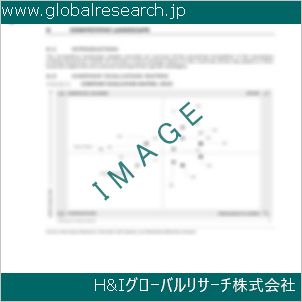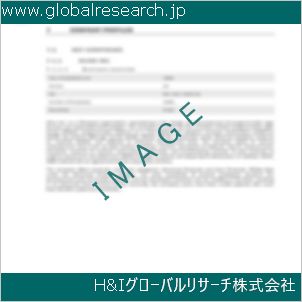Table of Contents
1 Industry Overview of Alminumhydride
1.1 Definition and Specifications of Alminumhydride
1.1.1 Definition of Alminumhydride
1.1.2 Specifications of Alminumhydride
1.2 Classification of Alminumhydride
1.3 Applications of Alminumhydride
1.3.1 Nuclear Application
1.3.2 Non-Nuclear Application
1.4 Industry Chain Structure of Alminumhydride
1.5 Industry Overview and Major Regions Status of Alminumhydride
1.5.1 Industry Overview of Alminumhydride
1.5.2 Global Major Regions Status of Alminumhydride
1.6 Industry Policy Analysis of Alminumhydride
1.7 Industry News Analysis of Alminumhydride
2 Manufacturing Cost Structure Analysis of Alminumhydride
2.1 Raw Material Suppliers and Price Analysis of Alminumhydride
2.2 Equipment Suppliers and Price Analysis of Alminumhydride
2.3 Labor Cost Analysis of Alminumhydride
2.4 Other Costs Analysis of Alminumhydride
2.5 Manufacturing Cost Structure Analysis of Alminumhydride
2.6 Manufacturing Process Analysis of Alminumhydride
3 Technical Data and Manufacturing Plants Analysis of Alminumhydride
3.1 Capacity and Commercial Production Date of Global Alminumhydride Major Manufacturers in 2023
3.2 Manufacturing Plants Distribution of Global Alminumhydride Major Manufacturers in 2023
3.3 R&D Status and Technology Source of Global Alminumhydride Major Manufacturers in 2023
3.4 Raw Materials Sources Analysis of Global Alminumhydride Major Manufacturers in 2023
4 Capacity, Production and Revenue Analysis of Alminumhydride by Regions, Types and Manufacturers
4.1 Global Capacity, Production and Revenue of Alminumhydride by Regions 2019-2024
4.2 Global and Major Regions Capacity, Production, Revenue and Growth Rate of Alminumhydride 2019-2024
4.3 Global Capacity, Production and Revenue of Alminumhydride by Types 2019-2024
4.4 Global Capacity, Production and Revenue of Alminumhydride by Manufacturers 2019-2024
5 Price, Cost, Gross and Gross Margin Analysis of Alminumhydride by Regions, Types and Manufacturers
5.1 Price, Cost, Gross and Gross Margin Analysis of Alminumhydride by Regions 2019-2024
5.2 Price, Cost, Gross and Gross Margin Analysis of Alminumhydride by Types 2019-2024
5.3 Price, Cost, Gross and Gross Margin Analysis of Alminumhydride by Manufacturers 2019-2024
6 Consumption Volume, Consumption Value and Sale Price Analysis of Alminumhydride by Regions, Types and Applications
6.1 Global Consumption Volume and Consumption Value of Alminumhydride by Regions 2019-2024
6.2 Global and Major Regions Consumption Volume, Consumption Value and Growth Rate of Alminumhydride 2019-2024
6.3 Global Consumption Volume and Consumption Value of Alminumhydride by Types 2019-2024
6.4 Global Consumption Volume and Consumption Value of Alminumhydride by Applications 2019-2024
6.5 Sale Price of Alminumhydride by Regions 2019-2024
6.6 Sale Price of Alminumhydride by Types 2019-2024
6.7 Sale Price of Alminumhydride by Applications 2019-2024
6.8 Market Share Analysis of Alminumhydride by Different Sale Price Levels
7 Supply, Import, Export and Consumption Analysis of Alminumhydride
7.1 Supply, Consumption and Gap of Alminumhydride 2019-2024
7.2 Global Capacity, Production, Price, Cost, Revenue, Supply, Import, Export and Consumption of Alminumhydride 2019-2024
7.3 USA Capacity, Production, Price, Cost, Revenue, Supply, Import, Export and Consumption of Alminumhydride 2019-2024
7.4 EU Capacity, Production, Price, Cost, Revenue, Supply, Import, Export and Consumption of Alminumhydride 2019-2024
7.5 China Capacity, Production, Price, Cost, Revenue, Supply, Import, Export and Consumption of Alminumhydride 2019-2024
7.6 Japan Capacity, Production, Price, Cost, Revenue, Supply, Import, Export and Consumption of Alminumhydride 2019-2024
8 Major Manufacturers Analysis of Alminumhydride
8.1 Manufacturer One
8.1.1 Company Profile
8.1.2 Product Picture and Specifications
8.1.2.1 Type I
8.1.2.2 Type II
8.1.2.3 Type III
8.1.3 Capacity, Production, Price, Cost, Gross and Revenue
8.1.4 Contact Information
8.2 Manufacturer Two
8.2.1 Company Profile
8.2.2 Product Picture and Specifications
8.2.2.1 Type I
8.2.2.2 Type II
8.2.2.3 Type III
8.2.3 Capacity, Production, Price, Cost, Gross and Revenue
8.2.4 Contact Information
8.3 Manufacturer Three
8.3.1 Company Profile
8.3.2 Product Picture and Specifications
8.3.2.1 Type I
8.3.2.2 Type II
8.3.2.3 Type III
8.3.3 Capacity, Production, Price, Cost, Gross and Revenue
8.3.4 Contact Information
8.4 Manufacturer Four
8.4.1 Company Profile
8.4.2 Product Picture and Specifications
8.4.2.1 Type I
8.4.2.2 Type II
8.4.2.3 Type III
8.4.3 Capacity, Production, Price, Cost, Gross and Revenue
8.4.4 Contact Information
8.5 Manufacturer Five
8.5.1 Company Profile
8.5.2 Product Picture and Specifications
8.5.2.1 Type I
8.5.2.2 Type II
8.5.2.3 Type III
8.5.3 Capacity, Production, Price, Cost, Gross and Revenue
8.5.4 Contact Information
…
9 Marketing Trader or Distributor Analysis of Alminumhydride
9.1 Marketing Channels Status of Alminumhydride
9.2 Traders or Distributors with Contact Information of Alminumhydride by Regions
9.3 Ex-work Price, Channel Price and End Buyer Price Analysis of Alminumhydride
9.4 Regional Import, Export and Trade Analysis of Alminumhydride
10 Industry Chain Analysis of Alminumhydride
10.1 Upstream Major Raw Materials Suppliers Analysis of Alminumhydride
10.1.1 Major Raw Materials Suppliers with Contact Information Analysis of Alminumhydride
10.1.2 Major Raw Materials Suppliers with Supply Volume Analysis of Alminumhydride by Regions
10.2 Upstream Major Equipment Suppliers Analysis of Alminumhydride
10.2.1 Major Equipment Suppliers with Contact Information Analysis of Alminumhydride
10.2.2 Major Equipment Suppliers with Product Pictures Analysis of Alminumhydride by Regions
10.3 Downstream Major Consumers Analysis of Alminumhydride
10.3.1 Major Consumers with Contact Information Analysis of Alminumhydride
10.3.2 Major Consumers with Consumption Volume Analysis of Alminumhydride by Regions
10.4 Supply Chain Relationship Analysis of Alminumhydride
11 Development Trend of Analysis of Alminumhydride
11.1 Capacity, Production and Revenue Forecast of Alminumhydride by Regions and Types
11.1.1 Global Capacity, Production and Revenue of Alminumhydride by Regions 2024-2029
11.1.2 Global and Major Regions Capacity, Production, Revenue and Growth Rate of Alminumhydride 2024-2029
11.1.3 Global Capacity, Production and Revenue of Alminumhydride by Types 2024-2029
11.2 Consumption Volume and Consumption Value Forecast of Alminumhydride by Regions, Types and Applications
11.2.1 Global Consumption Volume and Consumption Value of Alminumhydride by Regions 2024-2029
11.2.2 Global and Major Regions Consumption Volume, Consumption Value and Growth Rate of Alminumhydride 2024-2029
11.2.3 Global Consumption Volume and Consumption Value of Alminumhydride by Types 2024-2029
11.2.4 Global Consumption Volume and Consumption Value of Alminumhydride by Applications 2024-2029
11.3 Supply, Import, Export and Consumption Forecast of Alminumhydride
11.3.1 Supply, Consumption and Gap of Alminumhydride 2024-2029
11.3.2 Global Capacity, Production, Price, Cost, Revenue, Supply, Import, Export and Consumption of Alminumhydride 2024-2029
11.3.3 USA Capacity, Production, Price, Cost, Revenue, Supply, Import, Export and Consumption of Alminumhydride 2024-2029
11.3.4 EU Capacity, Production, Price, Cost, Revenue, Supply, Import, Export and Consumption of Alminumhydride 2024-2029
11.3.5 China Capacity, Production, Price, Cost, Revenue, Supply, Import, Export and Consumption of Alminumhydride 2024-2029
11.3.6 Japan Capacity, Production, Price, Cost, Revenue, Supply, Import, Export and Consumption of Alminumhydride 2024-2029
12 New Project Investment Feasibility Analysis of Alminumhydride
12.1 New Project SWOT Analysis of Alminumhydride
12.2 New Project Investment Feasibility Analysis of Alminumhydride
13 Conclusion of the Global Alminumhydride (CAS 7784-21-6) Industry 2024 Market Research Report
| ※参考情報 水素化アルミニウム(アルミニウムハイドライド)は、化学式 AlH₃ で表される無機化合物です。CAS番号は 7784-21-6 で、主に水素を含むアルミニウムの化合物です。この化合物は、水素を多く含んでいるため、特に水素エネルギーの分野で注目されています。 水素化アルミニウムは、固体の形態で存在し、通常は白色または灰色の結晶性粉末です。この物質は、比較的低い温度で熱分解し、アルミニウムと水素を生成します。場合によっては、他の化合物を合成する原料としても利用されます。水素化アルミニウムは、イオン性、金属結合性、共有結合性などの特性を持ち、化学的には安定していますが、触媒作用を持っているため、特定の条件下で高反応性を示します。 この化合物の主な特徴としては、高い水素含量が挙げられます。水素の重量比率は約10.6%であり、これにより、軽量エネルギー貯蔵材料としての利用が期待されています。また、アルミニウムは地球上で豊富に存在する元素であり、環境に優しいエネルギー貯蔵や運搬の方法として水素化アルミニウムは注目されています。 水素化アルミニウムはその性質から、さまざまな用途があります。一例として、水素エネルギーの貯蔵や輸送があります。水素はクリーンなエネルギー源として注目されていますが、その貯蔵と輸送方法が課題とされています。水素化アルミニウムを使うことで、金属水素化物として水素を安定的に保持し、必要な時に取り出すことが可能です。これにより、燃料電池や内燃機関などのエネルギー変換システムへと供給できるため、持続可能なエネルギーシステムの一環として利用されます。 また、化学合成の分野でも水素化アルミニウムは重要です。例えば、有機合成化学では、反応の還元剤として使用されます。特に、アルケンやアルデヒドの還元において、その効率性と選択性が高いため、多くの化学反応に貢献しています。さらには、医薬品の合成においても利用されることがあります。 水素化アルミニウムの種類には、いくつかの異なる形態があります。主に、無水物と水和物に分けられ、無水物は強い還元力を持ち、水和物は水分とともに存在することで安定性を増します。このように、特定の目的に応じた形態を選択することができます。 関連技術としては、ナノテクノロジーや新しい触媒技術が考えられます。ナノ材料としての水素化アルミニウムは、より軽量かつ高効率な水素貯蔵が可能であり、さまざまな実用化に向けた研究が進められています。この分野では、さらなる改良が期待されており、次世代のエネルギー技術に対する貢献が見込まれています。 水素化アルミニウムは、そのユニークな特性から今後さらに注目される物質です。環境問題やエネルギーの持続可能性が議論される中、水素化アルミニウムを利用した新たな技術や応用が見つかることで、よりクリーンで効率的なエネルギー供給が実現することが期待されています。今後の研究と開発が進むことで、もっと多様な分野での活用が広がっていくでしょう。 |
❖ 免責事項 ❖
http://www.globalresearch.jp/disclaimer












